外语教学理论与实践
语言学与语言教育二语习得与外语教学的最新理论与实践

语言学与语言教育二语习得与外语教学的最新理论与实践语言学和语言教育是紧密相关的学科领域。
在语言学中,二语习得是一个探讨人们学习第二语言的过程和规律的重要分支;而外语教学则关注如何有效地教授第二语言。
本文将介绍语言学与语言教育领域中最新的理论与实践,并探讨其对二语习得和外语教学的影响。
一、二语习得理论与实践1. 建构主义理论建构主义理论强调学习者通过与他人和环境的互动中建构知识。
在二语习得中,建构主义理论通过强调社交交互和语言输出的重要性,提倡学习者在真实的沟通环境中积极参与。
教师的角色是创造学习机会和提供适当的反馈。
2. 社会文化理论社会文化理论认为个体的认知和学习都是在社交环境中发展的。
在二语习得中,社会文化理论通过强调语言和文化之间的关系,鼓励学习者与母语使用者交流和参与社区实践。
这有助于学习者更好地理解语言的含义和使用方式。
3. 个别差异理论个别差异理论将学习者视为独特的个体,关注他们在语言习得过程中的差异。
在二语习得中,个别差异理论帮助教师了解学习者的个人差异,并提供个性化的教学策略和支持,以满足他们的学习需求。
二、外语教学理论与实践1. 沉浸式教学沉浸式教学是一种以目标语言为主要教学语言的教学方法。
在沉浸式教学中,学习者被置于一个使用目标语言的真实环境中,通过与母语使用者的交流来提高语言能力。
这种方法强调语言的实际应用和语言环境的重要性。
2. 任务型教学任务型教学注重学习者在解决实际任务的过程中使用语言。
任务型教学的目标是培养学习者的交际能力和问题解决能力。
通过给学习者真实的任务和情境,任务型教学激发了学习者的兴趣和积极性。
3. 投射理论投射理论认为语言学习是通过将新的语言知识与已有的认知结构相连接而实现的。
在外语教学中,投射理论强调让学习者将新学的语言知识与他们已有的知识和经验联系起来,促进语言习得的深入理解。
三、理论与实践的关系最新的理论对语言学与语言教育领域的实践产生了积极的影响。
读《现代外语教学:理论、实践与方法》札记

读《现代外语教学:理论、实践与方法》札记近期重温了《现代外语教学:理论、实践与方法》,有了新的感悟,也获得了更多的教育教学实践的经验和体会,受益匪浅。
该书在吸取当代西方外语教学理论研究成果的基础上,结合我国的外语教学实际,对影响外语教学的各种重要因素进行了较为详细的分析和讨论。
同时,对外语教学所涉及的实践和方法等方面的问题也进行了深入而广泛的介绍和探讨。
下面是笔者在阅读这本书的过程中所做的阅读笔记以及各个章节给我的一些感悟和启示。
绪论——呼唤具有中国特色的外语教学理论的指导书籍的封面简介概述了本书的主要思路:在吸取当代西方外语教学理论研究成果的基础上,结合我国的外语教学实际,对影响外语教与学的各种重要因素进行了较为详细的分析和讨论。
同时,对外语教学所涉及的实践和方法等方面的问题也进行了深入而广泛的介绍和探讨。
参加工作以来,也积累了较为丰富的教学经验,但是读过这本书后发现自己在外语教学理论研究方面还是不够,视野不够开阔,教学实践水平的发挥和教学质量的提高受到了很大影响。
绪论中提出中国的外语教学实践更需要自己的教学理论的指导。
外国的东西再好,毕竟不是从我们的实际出发,不适合我们的国情,因此不能直接应用。
不同语言背景和文化背景中的外语教学必须要有自己的外语教学理论。
教学中,我发现由于中西文化背景的不同带来的困惑和错误比比皆是,如在表示问候、告别以及表达个人愿望、拒绝、接受、感谢、谦虚等时的规则都有差异,这就要求我们把国外相关理论结合教学实践,灵活运用。
另外,我们学生学习外语的目的性过强,即考试,也就意味着除考试之外的日常应用,学生的积极性和兴趣都很低,口语表达能力弱。
因此,这也就要求教师课堂教学的目的不局限于为了培养学生的应试技巧,而要注重培养他们自主学习的能力、良好学习习惯及最基本的交际能力。
第一章当代外语教学理论研究中的几个重要发展趋势书的第一章探讨的是当代外语教学理论研究中的几个重要发展趋势,分为五节,给我感悟颇多。
外语教学理论与实践教学反思

外语教学理论与实践教学反思导言外语教学是指在非母语环境下,通过教师、教材以及教学方法等手段,对学习者进行语言技能、知识和文化的传授。
外语教学理论与实践是教育界广泛关注的一个领域,不断探索与创新外语教学模式,以提高学生的语言能力。
本文将从多个角度对外语教学理论与实践进行反思,以期对外语教学的改进有所启示。
一、传统教学模式的弊端在传统外语教学模式中,教师往往扮演着知识的传授者的角色,学生被动接受知识,缺乏主动性。
这种模式存在以下几个弊端:1. 缺乏互动和参与:传统教学模式以教师为中心,学生只是被动听讲和接受知识,缺少实际语言运用的机会,导致学生对外语学习的兴趣不高。
2. 掌握程度难以保证:学生仅凭记忆课本知识,难以真正理解和运用外语。
这种被动学习方式效果不佳,学生的语言掌握程度无法得到有效保证。
二、交际法在外语教学中的应用交际法是一种注重运用的教学方法,强调学生与教师、学生与学生之间的互动和交流。
交际法在外语教学中的应用能够有效改善传统教学模式的弊端。
1. 提供真实语境:交际法注重提供真实语境,让学生在实际交际中学习,帮助学生更好地掌握语言运用能力。
2. 促进学生参与:交际法鼓励学生互相交流和合作,激发学生的学习兴趣和动机。
3. 强调交际技能的培养:交际法注重培养学生的听、说、读、写技能,使学生能够在实际生活中流利地交流。
三、个性化教学的实施个性化教学是根据学生的特点和需求来设计教学内容和方法,以满足不同学生的学习需求。
个性化教学的实施可以激发学生的潜能,提高教学效果。
1. 综合评价:通过对学生的综合评价,了解学生的学习兴趣、强项和需求,根据不同学生的特点制定个性化教学计划。
2. 差异化指导:针对学生的不同水平和学习需求,采用不同的教学方法和教材,为每个学生提供有针对性的指导。
3. 个别辅导:提供个别辅导,帮助学生克服个人学习障碍,提高学习效果。
四、多媒体教学的优势多媒体教学是利用现代科技手段辅助教学,通过音、视、文字等多种形式给予学生知识的传授。
《现代外语教学--理论实践与方法》读后感

《现代外语教学--理论实践与方法》读后感篇一《现代外语教学--理论实践与方法》读后感嘿,朋友们!最近我读了一本叫《现代外语教学--理论实践与方法》的书,这可真是让我大开了眼界!你说这外语教学,以前我觉得不就是背单词、学语法嘛,能有多复杂?但这本书可真的是颠覆了我的想法。
也许你会问,这书真有这么神奇?我跟你说,还真有!书里讲了好多新鲜的理论和实践方法,就比如说那个情境教学法。
啥叫情境教学法?就是给你创造一个外语的环境,让你身临其境去感受。
我就想啊,这多好,总比死记硬背强多了吧?还有啊,它提到了个性化教学。
也许有人觉得,大家一起学不挺好的嘛,干嘛要个性化?但我觉得这可太重要了!每个人的学习方式和节奏都不一样,能根据自己的特点来学外语,那不是事半功倍吗?不过,我也在想,这些方法真的能在咱们的课堂上完全实现吗?可能会受到各种条件的限制吧。
但不管怎么说,这本书给了我们很多新思路。
读完这本书,我突然觉得自己对外语教学的理解太肤浅了。
以前觉得只要努力就能学好外语,现在才发现,方法不对,努力白费啊!你们说,未来的外语教学会不会变得更加有趣和高效呢?我觉得很有可能!篇二《现代外语教学--理论实践与方法》读后感哇塞,朋友们!我读完了《现代外语教学--理论实践与方法》这本书,感受颇多呀!你们知道吗?一开始我翻开这本书的时候,心里还嘀咕:“这能有啥新鲜的?”可谁能想到,我居然被它给“俘虏”了!这本书里讲的那些理论,有的真让我眼前一亮。
比如说,它强调了语言的交际功能。
我就想啊,咱们学外语不就是为了能和别人交流吗?老是纠结语法对不对,发音准不准,结果不敢开口,那不是白搭?还有那个多媒体教学的部分,我觉得特别有意思。
现在科技这么发达,用个视频、音频啥的来学外语,多带劲啊!但我又有点担心,万一过度依赖这些多媒体,会不会忽略了基础知识的学习呢?说到实践方法,有个小组合作学习让我印象深刻。
大家一起讨论、一起练习,也许效果会比自己一个人闷头学要好得多。
外语教育的理论与实践
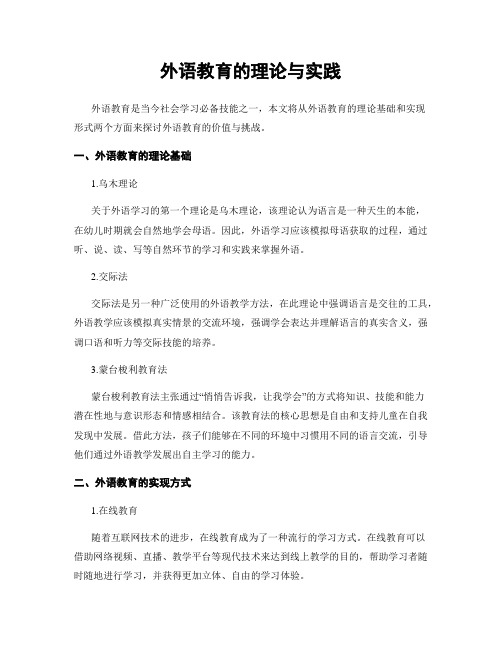
外语教育的理论与实践外语教育是当今社会学习必备技能之一,本文将从外语教育的理论基础和实现形式两个方面来探讨外语教育的价值与挑战。
一、外语教育的理论基础1.乌木理论关于外语学习的第一个理论是乌木理论,该理论认为语言是一种天生的本能,在幼儿时期就会自然地学会母语。
因此,外语学习应该模拟母语获取的过程,通过听、说、读、写等自然环节的学习和实践来掌握外语。
2.交际法交际法是另一种广泛使用的外语教学方法,在此理论中强调语言是交往的工具,外语教学应该模拟真实情景的交流环境,强调学会表达并理解语言的真实含义,强调口语和听力等交际技能的培养。
3.蒙台梭利教育法蒙台梭利教育法主张通过“悄悄告诉我,让我学会”的方式将知识、技能和能力潜在性地与意识形态和情感相结合。
该教育法的核心思想是自由和支持儿童在自我发现中发展。
借此方法,孩子们能够在不同的环境中习惯用不同的语言交流,引导他们通过外语教学发展出自主学习的能力。
二、外语教育的实现方式1.在线教育随着互联网技术的进步,在线教育成为了一种流行的学习方式。
在线教育可以借助网络视频、直播、教学平台等现代技术来达到线上教学的目的,帮助学习者随时随地进行学习,并获得更加立体、自由的学习体验。
2.传统的面授教育传统的外语教育更多是基于实体教室中的授课方式,借助于教材、教学游戏和互动模拟方式等,以传授语言基础知识和技能为主,通过训练听、说、读、写等各项语言技巧来提升学生的语言水平和口语表达能力。
3.移动学习移动学习是一种基于手机、平板电脑等移动终端设备的学习方式。
移动学习在外语学习中的应用越来越广泛,通过使用语音输入、在线翻译和聊天机器人等现代技术来辅助学习,使学习者可以更加轻松地进行学习和练习。
三、外语教育面临的挑战1.教学标准问题不同国家和地区的文化和语言有很大的差异,外语教育标准不仅需要面对语言技能和语言文化的面向,同时也需要对语言的发展和规范等细节问题进行考虑,以确保学生具备足够的语言素养。
外语教学的理论与实践创新
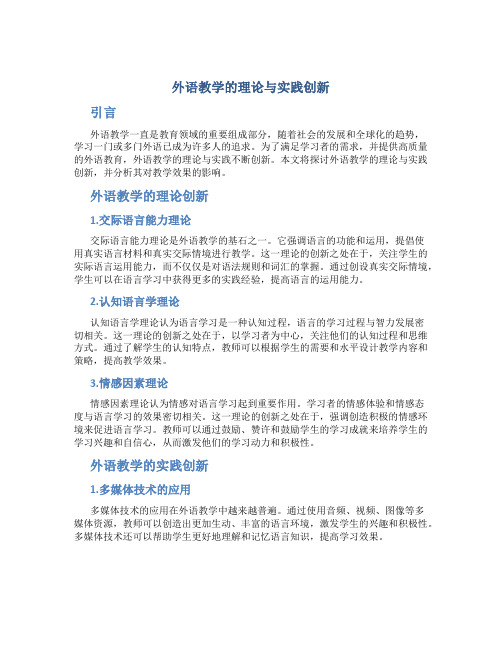
外语教学的理论与实践创新引言外语教学一直是教育领域的重要组成部分,随着社会的发展和全球化的趋势,学习一门或多门外语已成为许多人的追求。
为了满足学习者的需求,并提供高质量的外语教育,外语教学的理论与实践不断创新。
本文将探讨外语教学的理论与实践创新,并分析其对教学效果的影响。
外语教学的理论创新1.交际语言能力理论交际语言能力理论是外语教学的基石之一。
它强调语言的功能和运用,提倡使用真实语言材料和真实交际情境进行教学。
这一理论的创新之处在于,关注学生的实际语言运用能力,而不仅仅是对语法规则和词汇的掌握。
通过创设真实交际情境,学生可以在语言学习中获得更多的实践经验,提高语言的运用能力。
2.认知语言学理论认知语言学理论认为语言学习是一种认知过程,语言的学习过程与智力发展密切相关。
这一理论的创新之处在于,以学习者为中心,关注他们的认知过程和思维方式。
通过了解学生的认知特点,教师可以根据学生的需要和水平设计教学内容和策略,提高教学效果。
3.情感因素理论情感因素理论认为情感对语言学习起到重要作用。
学习者的情感体验和情感态度与语言学习的效果密切相关。
这一理论的创新之处在于,强调创造积极的情感环境来促进语言学习。
教师可以通过鼓励、赞许和鼓励学生的学习成就来培养学生的学习兴趣和自信心,从而激发他们的学习动力和积极性。
外语教学的实践创新1.多媒体技术的应用多媒体技术的应用在外语教学中越来越普遍。
通过使用音频、视频、图像等多媒体资源,教师可以创造出更加生动、丰富的语言环境,激发学生的兴趣和积极性。
多媒体技术还可以帮助学生更好地理解和记忆语言知识,提高学习效果。
2.任务型教学法的实践任务型教学法是一种注重语言运用和交际能力发展的教学方法。
通过设置真实的任务和情境,学生参与到语言交际中去,积极运用所学知识解决问题。
这种实践方法有助于提高学生的学习动机和合作能力,培养学生的实际语言运用能力。
3.跨文化交际的实践随着全球化的发展,跨文化交际的能力对外语学习者来说越来越重要。
外语实践教学法(3篇)

第1篇一、引言随着全球化的深入发展,外语教学在我国的地位越来越重要。
传统的课堂教学模式已经无法满足学生对外语学习的需求,因此,外语实践教学法的出现为外语教学带来了新的机遇和挑战。
本文将对外语实践教学法进行探讨,旨在为我国外语教学提供有益的借鉴。
二、外语实践教学法的内涵外语实践教学法是指在课堂教学中,教师通过创设真实或模拟的语言环境,引导学生参与各种语言实践活动,以提高学生的语言运用能力和综合素质的教学方法。
实践教学法强调学生的主体地位,注重培养学生的自主学习能力、创新能力和实际操作能力。
三、外语实践教学法的原则1. 实用性原则:实践教学法应以培养学生的实际语言运用能力为目标,教学内容应紧密结合学生的实际需求,提高学生的外语水平。
2. 创新性原则:实践教学法应不断更新教学内容和方法,以适应时代发展和学生需求的变化。
3. 合作性原则:实践教学法鼓励学生之间的合作与交流,培养学生的团队精神和协作能力。
4. 个性化原则:实践教学法应关注学生的个体差异,因材施教,激发学生的学习兴趣和潜能。
四、外语实践教学法的实施策略1. 创设真实或模拟的语言环境(1)利用多媒体技术,将真实的语言材料引入课堂,如视频、音频、图片等,提高学生的语言感知能力。
(2)组织学生参与角色扮演、情景模拟等活动,让学生在实际语境中运用所学知识。
2. 开展多样化的语言实践活动(1)组织学生进行小组讨论、辩论、演讲等活动,提高学生的口语表达能力。
(2)开展写作、翻译、语法练习等活动,培养学生的书面表达能力。
(3)组织学生参与课外活动,如英语角、英语演讲比赛等,拓宽学生的语言交际渠道。
3. 强化教师引导作用(1)教师应关注学生的学习需求,制定合理的教学计划,确保实践教学法的有效实施。
(2)教师应引导学生积极参与实践活动,激发学生的学习兴趣。
(3)教师应关注学生的个体差异,因材施教,提高教学效果。
4. 营造良好的学习氛围(1)建立积极、和谐、向上的课堂氛围,让学生在轻松愉快的氛围中学习。
外语教学的理论与实践

外语教学的理论与实践外语教学是一门综合性很强的学科,包含了语言学、语言教学法、教育学等学科的内容。
对于外语教学的理论和实践,可以从以下几个方面展开探讨。
一、外语教学的理论1.语言学理论外语教学的理论基础是语言学,它包括音、形、义和用法等多个方面。
普通话的语音、语调、语素等都需要在外语教学中作为重要的素材。
2.语言习得理论语言习得理论是外语教学中很重要的一部分,它研究了外语学习者在语言习得过程中的各个阶段和规律。
因此,学生在外语学习过程中应该从自己的语言认知能力出发,有针对性的将知识点牢记于心。
3.教育学理论教育学理论是外语教学的指导思想。
对于语言习得者而言,每个学生的学习能力和学习方法都不同,因此,老师需要对学生的个性化需求有所了解。
二、外语教学的实践1.教学内容的选择外语教学的教学内容应该根据学生的实际情况和学生自身的特点来选择,老师可以根据学生兴趣程度、年龄、语言认知能力来选择教学内容,以激发学生的学习兴趣和思维发展。
2.教学方法的灵活运用外语教学是需要灵活运用教学方法的过程,老师应该根据学生的不同阶段、能力、学习方式等多种因素来选择不同的教学方法。
如:运用小组活动、语言任务和语言对话等活动,让学生在互动交流中加深对外语的理解。
3.自我反思和教学改进教学工作的不断变化和进步需要老师们不断进行自我反思和教学改进。
老师应该不断根据教学效果和学生反应来深思熟虑,整理和反思自己的教学方法及方式,更好地让学生掌握外语知识。
三、结论外语教学需要注重理论和实践相结合,让学生根据自己的个性化需求和语言认知能力来选择适合自己的教学方式和方法。
教师应该根据不同学生的实际情况和能力来选择合适的教学方式,以让学生真正掌握外语知识。
同时,老师也需要不断进行教学改进和自我反思,不断更新自己的教学理念和教学方式,为学生的语言学习之路铺开一条开阔的道路。
外语教学理论的发展与实践
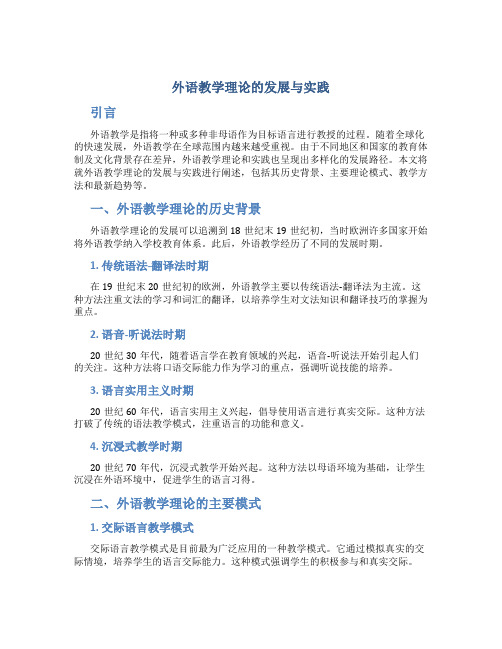
外语教学理论的发展与实践引言外语教学是指将一种或多种非母语作为目标语言进行教授的过程。
随着全球化的快速发展,外语教学在全球范围内越来越受重视。
由于不同地区和国家的教育体制及文化背景存在差异,外语教学理论和实践也呈现出多样化的发展路径。
本文将就外语教学理论的发展与实践进行阐述,包括其历史背景、主要理论模式、教学方法和最新趋势等。
一、外语教学理论的历史背景外语教学理论的发展可以追溯到18世纪末19世纪初,当时欧洲许多国家开始将外语教学纳入学校教育体系。
此后,外语教学经历了不同的发展时期。
1. 传统语法-翻译法时期在19世纪末20世纪初的欧洲,外语教学主要以传统语法-翻译法为主流。
这种方法注重文法的学习和词汇的翻译,以培养学生对文法知识和翻译技巧的掌握为重点。
2. 语音-听说法时期20世纪30年代,随着语言学在教育领域的兴起,语音-听说法开始引起人们的关注。
这种方法将口语交际能力作为学习的重点,强调听说技能的培养。
3. 语言实用主义时期20世纪60年代,语言实用主义兴起,倡导使用语言进行真实交际。
这种方法打破了传统的语法教学模式,注重语言的功能和意义。
4. 沉浸式教学时期20世纪70年代,沉浸式教学开始兴起。
这种方法以母语环境为基础,让学生沉浸在外语环境中,促进学生的语言习得。
二、外语教学理论的主要模式1. 交际语言教学模式交际语言教学模式是目前最为广泛应用的一种教学模式。
它通过模拟真实的交际情境,培养学生的语言交际能力。
这种模式强调学生的积极参与和真实交际。
2. 任务型语言教学模式任务型语言教学模式是基于真实生活中的任务设计的。
它通过解决实际任务来促进学生的语言学习和使用能力。
这种模式注重学生的探究和合作,强调语言运用的功能。
3. 社会文化学习模式社会文化学习模式以社会文化背景为基础,将语言教学与文化教学相结合。
它通过培养学生的跨文化意识,促进学生的文化理解和跨文化交际能力。
4. 个性化语言教学模式个性化语言教学模式注重学生的个体差异和兴趣,以个人化的学习方式和内容为主。
浅谈英语有效教学理论与实践相结合的经验

浅谈英语有效教学理论与实践相结合的经验教学不仅仅是一门艺术,教学也是科学。
这就告诉我们,教学可以用科学方法来研究。
在英语教学中进行有效教学,通过实践,取得了良好的教学效益。
有效教学专业技能情感技能有效教学的提出,其实是“教育是艺术还是科学”之间相互争论的产物。
随着教学科学化运动的扎实推进,普遍认为,教学也是科学,教学不仅仅是一门艺术,更是科学。
这就告诉我们,教学不仅有科学的基础,而且可以用科学方法来研究。
有效教学理念就是在这一背景下提出来的。
我认为,其核心问题就是教学效益,即什么样的教学是有效的?是高效、低效还是无效?到底采用什么样的策略,才能实现有效教学呢?一、专业技能教学方法1.创建积极课堂环境,激发学生学习兴趣我看到过这样一个故事,一个青年求教于苏格拉底:“我想获得知识……”苏格拉底将青年带到海里,海水淹没了年轻人,他奋力挣扎才将头探出水面。
苏格拉底问:“你在水里最大的愿望是什么?”“空气,当然是呼吸新鲜空气!”“学习就得使上这股劲!”这则故事中的苏格拉底告诉我们:积极主动学习的基础就是有一种迫切的“需要”。
就是这种需要会产生学习的动机,产生一种学习的积极性。
学生有了学习动力,接下来的任务就是如何让学生们保持这种动力,那就是激发学生的学习兴趣。
英语课堂上能不能抓住学生的注意力,防止学习疲劳,创造积极的学习氛围,是一个老师受不受学生欢迎和喜爱的标准之一。
我们在实践当中总结了以下几点:第一,用幽默语言调节英语课堂。
幽默的语言是调味剂,在课堂教学中使用幽默成分,也使原本乏味的课堂讲授充满了生机,活跃了课堂气氛,增进了老师和学生之间的关系。
我经常总结一些和英语有关的笑话、趣事还有一些绕口令之类的材料,在课堂学习的时候如果出现相关的语言学习我就可以把我总结的材料加入课堂学习中,增加学习乐趣。
比如,在讲到单词farther的时候,可以给大家提个问题:dad and mom, who is closer to you? 答案是mom ,because father is farther.第二,用游戏点缀英语课堂教学。
外语教育理论与实践

外语教育理论与实践引言:外语教育作为一门学科,旨在培养学生的外语能力,使其能够在跨文化交流中自如地运用外语。
本文将从外语教育的理论和实践两个方面来探讨如何提高外语教学的效果。
一、外语教育的理论基础1. 语言习得理论语言习得理论认为语言是人类天生的能力,与学习语言的能力是不同的。
教师应该创造一个自然的语言环境,让学生通过接触和使用语言来习得外语。
2. 交际语言学理论交际语言学理论强调语言是用来交际的工具,交际能力是外语学习的核心目标。
教师应该注重培养学生的交际能力,让他们能够在真实的交际情境中运用外语。
3. 语言教学方法论语言教学方法论主要包括语法-翻译法、直接法、听说法、综合法等。
教师应该根据学生的特点和学习目标选择合适的教学方法,提高教学效果。
二、外语教育的实践策略1. 创设真实情境教师可以通过模拟真实情境,如商务会谈、旅游问路等,让学生在真实的情境中运用外语。
这样可以提高学生的交际能力和语言运用能力。
2. 引入多媒体技术多媒体技术可以使教学更加生动有趣。
教师可以利用电子白板、多媒体课件等工具,展示图片、视频等多媒体资源,激发学生的学习兴趣。
3. 个性化教学每个学生都有自己的学习特点和学习节奏,教师应该根据学生的差异性进行个性化教学。
可以采用小组合作学习、任务型学习等方式,让学生在合作中相互促进,提高学习效果。
4. 激发学生学习的内在动力学生的学习动力对于学习效果有着重要的影响。
教师可以通过鼓励、奖励等方式激发学生的学习兴趣和自主学习的能力,提高学习效果。
结论:外语教育的理论和实践相辅相成,只有理论和实践相结合,才能取得更好的教学效果。
教师应该不断学习和探索,不断提高自己的教学水平,为学生提供更好的外语教育。
外语教师专业发展的理论与实证研究

外语教师专业发展的理论与实证研究一、本文概述《外语教师专业发展的理论与实证研究》一文旨在深入探讨外语教师专业发展的理论与实践。
本文首先对外语教师专业发展的重要性进行阐述,指出教师专业发展对于提高外语教学质量、推动教育改革以及培养国际化人才的关键作用。
随后,文章从理论层面出发,梳理了外语教师专业发展的相关理论框架,包括教师发展阶段理论、教师专业素养模型等,为实证研究提供了理论基础。
在实证研究方面,本文采用了多种研究方法,如问卷调查、访谈、课堂观察等,以收集关于外语教师专业发展的实际数据。
通过对数据的分析,文章揭示了外语教师专业发展的现状、存在的问题以及影响因素,为制定有效的教师发展策略提供了依据。
本文旨在通过理论与实证相结合的研究,为外语教师专业发展提供全面的分析和建议。
通过深入研究外语教师专业发展的内涵、特点与规律,本文期望为外语教育领域的教师培养、教育改革以及国际化人才培养贡献新的力量。
本文也期望能够引起广大外语教育工作者对教师专业发展的关注和重视,共同推动外语教育事业的持续发展。
二、外语教师专业发展的理论基础外语教师专业发展是一个涉及多元理论框架和实践策略的领域,其理论基础主要包括教育心理学、成人学习理论、教师教育和教师发展理论等。
这些理论为外语教师的专业成长提供了全面的视角和深入的洞察。
教育心理学为外语教师专业发展提供了对学生学习过程和教师教学方法的深入理解。
特别是认知心理学和行为主义理论,它们揭示了语言学习的心理机制和有效的教学策略。
这些理论强调教师应该根据学生的认知特点和语言学习规律来设计教学活动,以提高学生的语言能力和学习效果。
成人学习理论对外语教师专业发展同样具有重要意义。
成人学习者具有自我导向、经验为基础、问题为中心等学习特点,这要求外语教师在专业发展过程中注重自我反思、实践探索和持续学习。
成人学习理论还强调了学习环境、学习动机和学习策略对成人学习的重要影响,这为外语教师提供了优化学习环境、激发学习动机和指导学习策略的理论依据。
外语教学理论实践(3篇)
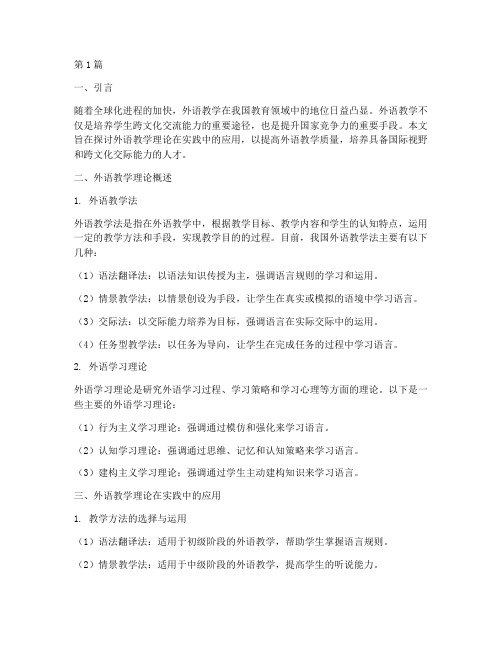
第1篇一、引言随着全球化进程的加快,外语教学在我国教育领域中的地位日益凸显。
外语教学不仅是培养学生跨文化交流能力的重要途径,也是提升国家竞争力的重要手段。
本文旨在探讨外语教学理论在实践中的应用,以提高外语教学质量,培养具备国际视野和跨文化交际能力的人才。
二、外语教学理论概述1. 外语教学法外语教学法是指在外语教学中,根据教学目标、教学内容和学生的认知特点,运用一定的教学方法和手段,实现教学目的的过程。
目前,我国外语教学法主要有以下几种:(1)语法翻译法:以语法知识传授为主,强调语言规则的学习和运用。
(2)情景教学法:以情景创设为手段,让学生在真实或模拟的语境中学习语言。
(3)交际法:以交际能力培养为目标,强调语言在实际交际中的运用。
(4)任务型教学法:以任务为导向,让学生在完成任务的过程中学习语言。
2. 外语学习理论外语学习理论是研究外语学习过程、学习策略和学习心理等方面的理论。
以下是一些主要的外语学习理论:(1)行为主义学习理论:强调通过模仿和强化来学习语言。
(2)认知学习理论:强调通过思维、记忆和认知策略来学习语言。
(3)建构主义学习理论:强调通过学生主动建构知识来学习语言。
三、外语教学理论在实践中的应用1. 教学方法的选择与运用(1)语法翻译法:适用于初级阶段的外语教学,帮助学生掌握语言规则。
(2)情景教学法:适用于中级阶段的外语教学,提高学生的听说能力。
(3)交际法:适用于中高级阶段的外语教学,培养学生的实际交际能力。
(4)任务型教学法:适用于所有阶段的外语教学,提高学生的综合运用能力。
2. 教学内容的安排(1)根据学生需求确定教学内容:了解学生的兴趣爱好、学习目标等,有针对性地选择教学内容。
(2)注重跨文化内容:在教学内容中融入跨文化元素,提高学生的跨文化交际能力。
(3)结合实际生活:将教学内容与学生的实际生活相结合,提高学生的学习兴趣和动力。
3. 教学策略的运用(1)启发式教学:引导学生主动思考、探究,提高学生的自主学习能力。
新时代中国特色外语教育理论与实践

新时代中国特色外语教育理论与实践一、本文概述随着全球化进程的加速和中国国际地位的日益提升,外语教育在中国教育体系中的地位愈发重要。
本文旨在探讨新时代中国特色外语教育的理论与实践,分析外语教育在当前社会背景下的发展趋势与挑战,并提出相应的应对策略。
通过对中国特色外语教育的深入研究,本文旨在为推动中国外语教育的改革与发展提供理论支撑和实践指导。
文章首先对外语教育的历史沿革进行了简要回顾,梳理了外语教育在中国的发展历程和取得的成就。
在此基础上,文章分析了新时代外语教育的特点与要求,包括培养具有全球视野、跨文化交际能力的新时代人才,以及服务国家发展战略、推动构建人类命运共同体的需要。
接着,文章重点探讨了中国特色外语教育的理论与实践。
在理论层面,文章阐述了中国特色外语教育的理论体系,包括教育理念、教学目标、课程内容、教学方法等方面的创新与实践。
在实践层面,文章通过案例分析、实证研究等方法,深入探讨了中国特色外语教育的实施路径和成效评估,为外语教育实践提供了有益的参考。
文章总结了新时代中国特色外语教育的成就与经验,并展望了未来的发展趋势。
在全球化背景下,中国特色外语教育将继续深化改革,创新教育理念和方法,培养更多具有国际视野和跨文化交际能力的新时代人才,为实现中华民族伟大复兴的中国梦贡献力量。
二、新时代外语教育的时代背景随着全球化的深入发展,外语教育在中国特色社会主义进入新时代的背景下,迎来了前所未有的发展机遇与挑战。
当前,世界正处于百年未有之大变局,国际力量对比、全球治理体系、国际经济格局和科技发展态势都在发生深刻变化。
中国作为世界第二大经济体,正积极参与全球治理,推动构建人类命运共同体,这要求新时代的外语教育不仅要培养具有国际视野、通晓国际规则、能够参与国际事务和国际竞争的国际化人才,还要培养能够讲好中国故事、传播好中国声音、阐释好中国特色、贡献中国智慧、展现中国形象的跨文化交流使者。
在新时代背景下,外语教育的目标更加明确,任务更加艰巨。
英语教学理论与实践

张伊那语言教学理论和实践7月12日内容第一讲语言观与语言学习观思考题:什么是语言?外语教学教什么?第一代:传统语言教学无自觉的语言观,想当然的把语言做为一门知识教。
包括语法知识、词汇、知识和语音知识第二代:结构主义语言观语言是一套形式结构,一套符号系统受行为主义心理学的影响,人们认为,学语言就是要获得操作这套符号系统的技能,用行为主义心理学的术语说,就是训练对刺激作出正确反映的一套语言习惯。
因而,教学一门语言就是通过反复几次训练学生正确操作这门语言的(即一套形式系统)的各种技能。
第三代:交流语言观不仅是以上两种,而是获取人与人交际的一种能力。
能力不排除知识和技能,但是也不等于知识和技能,而是把知识和技能包含进去的,性质起了变化的综合体。
教语言不能停留于教知识、教技能,而要培养能力。
思考题:何为交际能力?交际能力大于语言能力,且包含语言能力交际能力有三个范畴的能力(包含知识、技能、能力)组成:1.语言能力:语言形式结构系统本身的操作能力2.语篇能力:语言形式结构置于语篇中运用的能力3.语用能力:语言形式结构置于情境中运用的能力思考题:交际语言观对语言教学的启示?语言教学必须注意培养以下三个范畴的能力1.语言、语法、词汇知识、词和句的语义知识,听、说、读、写的技能2.语篇规则的知识,语篇组织能力,语篇连接策略等3.实现语言功能的能力、交际策略、社会语言能力、社会文化知识、关于世界的知识等《英语课程标准》所体现的语言观“语言是人类最重要的思维和句,也是人们参与社会的重要条件。
语言对促进人的全面发展具有重要意义。
”“高中学生学习外语,一方面可以促进心智、情感、态度与价值观的发展和综恩问素养的提高;另一方面,掌握一门国际通用语种可以为学习国外先进的文化科学、技术和进行国际交往创造条件。
“注:语言的工具性和人文性有机结合,高度统一。
工具性与人文性也是教育的两大功能。
思考题:人们是如何学习语言的?历史上形形色色的外语学习理论可归结为两个方面相反的主要趋向:1.把人学习外语外语看作是一套心理生理习惯的形成,这是通过模仿和刺激反应的技能训练2.认为人学习外语是在自己的脑子里构造一套新的知识(陈述性知识和程序性知识)系统,这构造的过程强调创造性及认知和情感机能的作用。
外语教育理论与实践结合的研究

外语教育理论与实践结合的研究外语教育是一个重要的教育领域,随着全球化的发展和国际交流的增加,掌握一门或多门外语成为现代人的基本素养。
然而,传统的外语教育模式往往以理论为主,忽视了实践的重要性。
因此,外语教育理论与实践结合的研究变得尤为重要。
首先,外语教育的理论研究为实践提供了指导。
理论研究旨在系统地阐述外语教育的原理、方法和技巧。
它可以帮助教师更好地理解学习者的语言习得过程,了解他们面临的困难和障碍。
这样一来,教师可以根据理论研究的成果调整教学方法和教学内容,提高教学质量。
另外,实践经验是外语教育的重要组成部分。
它是教师通过实际教学和丰富的教学实践积累的经验总结与分享。
通过实践,教师可以发现、解决问题,积累有效的教学方法和策略。
这些实践经验可以为理论研究提供宝贵的参考,帮助理论更加贴近实际,增强其可操作性。
外语教育理论与实践结合的研究,旨在将二者相互交融,实现相辅相成的效果。
理论研究为实践提供指导,而实践经验为理论提供验证和完善。
只有二者结合,才能更好地提升外语教育的质量。
一种将外语教育理论与实践结合的方法是教师专业发展。
教师通过持续的专业发展,不断学习新的理论知识和教学方法,并将其运用到实际教学中。
这样的专业发展包括参加教师培训、研讨会、学术会议等活动,以及参观其他教学机构或国家的外语教学实践。
通过这些活动,教师可以接触到最新的理论研究成果和教学实践经验,进一步提升自己的教学能力和水平。
另一个将外语教育理论与实践结合的方法是教学实践研究。
教学实践研究是指教师在实际教学中对教学过程和效果进行反思和研究。
通过教学实践研究,教师可以深入分析学生的学习情况和表现,了解不同教学方法对学生学习的影响。
同时,教师还可以通过实地调研和观察,了解学生所处的语言环境和文化背景,为教学内容的选择和设计提供依据。
除了教师专业发展和教学实践研究,外语教育理论与实践结合的研究还可以通过教材编写和课程设计来实现。
教材编写和课程设计是将理论知识和实践经验转化为实际教学内容和活动的过程。
外语学习中的语言学习理论与实践
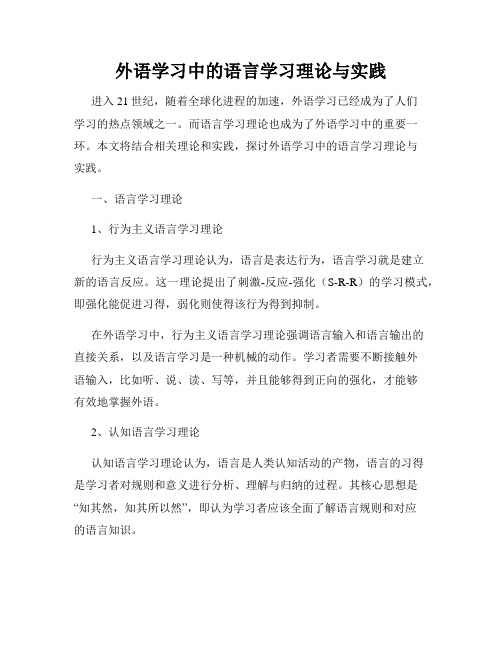
外语学习中的语言学习理论与实践进入21世纪,随着全球化进程的加速,外语学习已经成为了人们学习的热点领域之一。
而语言学习理论也成为了外语学习中的重要一环。
本文将结合相关理论和实践,探讨外语学习中的语言学习理论与实践。
一、语言学习理论1、行为主义语言学习理论行为主义语言学习理论认为,语言是表达行为,语言学习就是建立新的语言反应。
这一理论提出了刺激-反应-强化(S-R-R)的学习模式,即强化能促进习得,弱化则使得该行为得到抑制。
在外语学习中,行为主义语言学习理论强调语言输入和语言输出的直接关系,以及语言学习是一种机械的动作。
学习者需要不断接触外语输入,比如听、说、读、写等,并且能够得到正向的强化,才能够有效地掌握外语。
2、认知语言学习理论认知语言学习理论认为,语言是人类认知活动的产物,语言的习得是学习者对规则和意义进行分析、理解与归纳的过程。
其核心思想是“知其然,知其所以然”,即认为学习者应该全面了解语言规则和对应的语言知识。
在外语学习中,认知语言学习理论主张学生应该具有多角度地接受和处理语言信息的能力,不仅仅是简单的机械记忆,还应该注重对语言背景、词汇、语法知识等的学习。
3、社会文化语言学习理论社会文化语言学习理论强调了语言的社会和文化背景,认为人们的语言和思维受到社会文化环境的影响。
因此,语言学习的主要内容应该是学习交流能力,了解并适应社会文化环境。
在外语学习中,社会文化语言学习理论提醒学习者应该重视听说能力,这是学习交流的核心能力。
同时,在语言学习中,了解并适应目标语言国家的文化背景也非常重要。
二、语言学习实践1、语言环境语言环境对于外语学习者的语言习得有着决定性的作用。
创造良好的语言环境,可以提高学生的语言水平和语言应用能力。
比如,学生可以通过参加语言学校、语言实习、交换生和海外留学等方式改善语言环境条件,加强语言表达能力、交流能力和人际社交能力。
此外,提供各类外语教育资源、利用数字化技术等方式,也可以为学生提供更好的语言环境和资源。
外语教学实践理论(3篇)
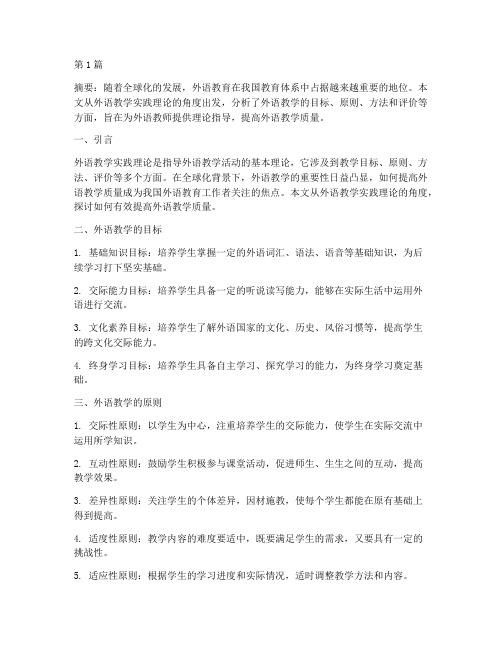
第1篇摘要:随着全球化的发展,外语教育在我国教育体系中占据越来越重要的地位。
本文从外语教学实践理论的角度出发,分析了外语教学的目标、原则、方法和评价等方面,旨在为外语教师提供理论指导,提高外语教学质量。
一、引言外语教学实践理论是指导外语教学活动的基本理论,它涉及到教学目标、原则、方法、评价等多个方面。
在全球化背景下,外语教学的重要性日益凸显,如何提高外语教学质量成为我国外语教育工作者关注的焦点。
本文从外语教学实践理论的角度,探讨如何有效提高外语教学质量。
二、外语教学的目标1. 基础知识目标:培养学生掌握一定的外语词汇、语法、语音等基础知识,为后续学习打下坚实基础。
2. 交际能力目标:培养学生具备一定的听说读写能力,能够在实际生活中运用外语进行交流。
3. 文化素养目标:培养学生了解外语国家的文化、历史、风俗习惯等,提高学生的跨文化交际能力。
4. 终身学习目标:培养学生具备自主学习、探究学习的能力,为终身学习奠定基础。
三、外语教学的原则1. 交际性原则:以学生为中心,注重培养学生的交际能力,使学生在实际交流中运用所学知识。
2. 互动性原则:鼓励学生积极参与课堂活动,促进师生、生生之间的互动,提高教学效果。
3. 差异性原则:关注学生的个体差异,因材施教,使每个学生都能在原有基础上得到提高。
4. 适度性原则:教学内容的难度要适中,既要满足学生的需求,又要具有一定的挑战性。
5. 适应性原则:根据学生的学习进度和实际情况,适时调整教学方法和内容。
四、外语教学方法1. 任务型教学法:通过设计真实、具体的任务,让学生在完成任务的过程中掌握语言知识和技能。
2. 合作学习法:通过小组合作,培养学生的团队协作能力和沟通能力。
3. 情景教学法:创设真实、生动的情景,让学生在情景中学习语言。
4. 信息技术辅助教学法:利用多媒体、网络等信息技术手段,提高教学效果。
5. 文化教学法:通过介绍外语国家的文化,提高学生的跨文化交际能力。
- 1、下载文档前请自行甄别文档内容的完整性,平台不提供额外的编辑、内容补充、找答案等附加服务。
- 2、"仅部分预览"的文档,不可在线预览部分如存在完整性等问题,可反馈申请退款(可完整预览的文档不适用该条件!)。
- 3、如文档侵犯您的权益,请联系客服反馈,我们会尽快为您处理(人工客服工作时间:9:00-18:30)。
Can collocations be learned incidentally through reading while listening to a modified graded reader?
How many encounters with collocations are needed to incidentally learn the written form of the collocations under the above condition? How many encounters with collocations are needed to incidentally learn the form and meaning of the collocations under the above condition?
Defining collocation
refers to the regular standpoint co-occurrence of words within a (corpus linguistics) given span demonstrating a statistical strength of co-occurrence in this study 18 target collocations from the General Service List (West, 1953) & 1,000 word families in British National Corpus lists (Nation, 2004)
00
01
1st Posttest productive knowledge of form e.g. remember time remember _____
2nd Posttest
receptive knowledge of form
02
/identical to pretest with a
different order
statistical
01
+listening indication of form (without pauses)
reading while listening
Brown et al. (2008) greater incidental vocabulary learning
Theoretical significance
/L2-L1 translation e.g. meet demand _____
To answer Q1
To answer Q1
Encountering collocations when reading while listening contributed to incidental learning of collocation.
Q1
To answer Q2
(receptive form)
To answer Q2
(productive form)
55%
To answer Q3
26%
53%
73%
82%
Collocations can be learned incidentally through reading while listening to a graded reader.
03
3rd Posttest productive knowledge of form and meaning /L1-L2 translation
4th Posttest
receptive knowledge of
04
e.g. meet demand 满足需要
Language Learning 63:1, March 2013, pp. 91-120
Literature review
01
Research Qs & theoretical significance
04
Research findings & limitations
Contents
03
Research methodology & design
1 control group
4 experimental groups
Pretest 1 week/ receptive knowledge of form (multiple-choice) e.g. break silence break a) desk b) final c) silence d) light e) I don’t know
Incidental Learning of Collocation
Stuart Webb
Victoria University of Wellington
Jonathan Newton
Victoria University of Wellington
Anna Chang
Hsing-Wu University
A test order effect
Critique
References Boers, F., Demecheleer, M., & Eyckmans, J. (2004). Etymological elaboration as a strategy for learning figurative idioms. In P. Bogaards & B. Laufer (Eds.), Vocabulary in a second language: Selection, acquisition and testing (pp. 53–78). Amsterdam: John Benjamins. Chan, T. P., & Liou, H. C. (2005). Effects of web-based concordancing instruction on EFL students’ learning of verb-noun collocations. Computer Assisted Language Learning, 18, 231–251. Hunt, A., & Beglar, D. (2005). A framework for developing EFL reading vocabulary. Reading in a Foreign Language, 17, 23–59. Laufer, B. (2001). Reading, word-focused activities and incidental vocabulary acquisition in a second language. Prospect, 16(3), 44–54. Laufer, B. (2003).Vocabulary acquisition in a second language: Do learners really acquire most vocabulary by reading? Canadian Modern Language Review, 59, 565–585. Laufer, B., & Girsai, N. (2008). Form-focused instruction in second language vocabulary learning: A case for contrastive analysis and translation. Applied Linguistics, 29, 694–716. Lindstromberg, S., & Boers, F. (2008b). The mnemonic effect of noticing alliteration in lexical chunks. Applied Linguistics, 29, 200–222.
Modified reader
Oxford Bookworms graded reader
New Yorkers
with target collocations inserted
Method
design
Experimental Group 1: once Experimental Group 5: 5 times Experimental Group 10: 10 times Experimental Group 15: 15 times
The number of encounters has a positive effect on learning. 15 times/sizeable learning gains
Using collocations made up of nonsense words
Prior The knowledge of measurement the of form and constituent meaning. items
02
incidental vocabulary learning /valuable part
Literature review
focus exclusively /single-word items+
collocations/explicit teaching
Research questions
References Nation, I. S. P. (2001). Learning vocabulary in another language. Cambridge, UK: Cambridge University Press. Nation, I. S. P. (2008). Teaching vocabulary: Strategies and techniques. Boston: Heinle. Nation, I.S.P., & Webb, S. (2011). Researching and analyzing vocabulary. Boston: Heinle. Schmitt, N. (2000). Vocabulary in language teaching. Cambridge, UK: Cambridge University Press. Schmitt, N. (2008). Review article: Instructed second language vocabulary learning. Language Teaching Research, 12, 329–363. Sun, Y. -C., & Wang, L.-Y. (2003). Concordancers in the EFL classroom: Cognitive approaches and collocation difficulty. Computer Assisted Language Learning, 16, 83–94. Webb, S., & Chang, C-S. A. (2012). Second language vocabulary growth. RELC Journal, 43, 113–126. Webb, S., & Kagimoto, E. (2009). The effects of vocabulary learning on collocation and meaning. TESOL Quarterly, 43, 55–77. Webb, S., & Kagimoto, E. (2011). Learning collocation: Do the number of collocates, position of the node word, and synonymy affect learning? Applied Linguistics, 32, 259–276.
